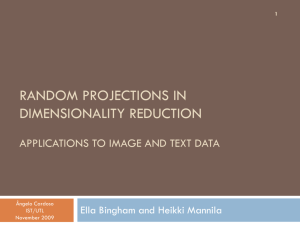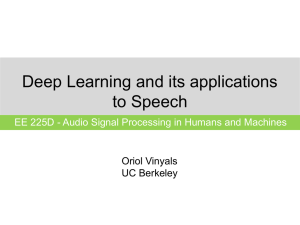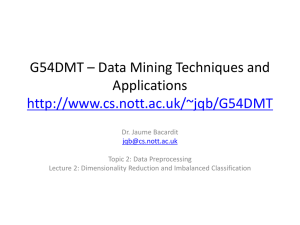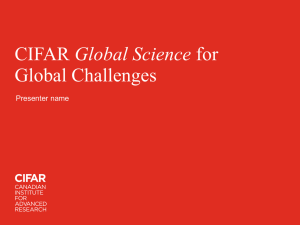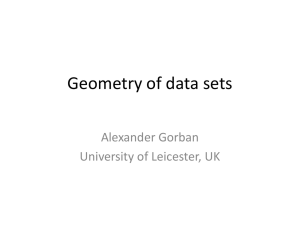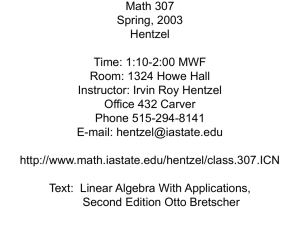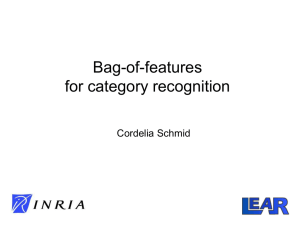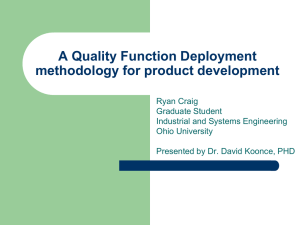Slides (PPT) - University of Oxford
advertisement
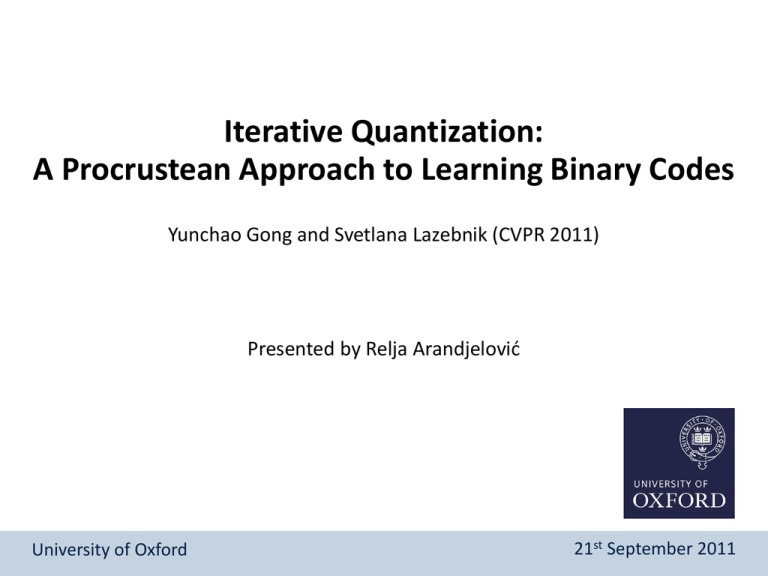
Iterative Quantization: A Procrustean Approach to Learning Binary Codes Yunchao Gong and Svetlana Lazebnik (CVPR 2011) Presented by Relja Arandjelović University of Oxford 21st September 2011 Objective Construct similarity-preserving binary codes for highdimensional data Requirements: Similar data mapped to similar binary strings (small Hamming distance) Short codes – small memory footprint Efficient learning algorithm Related work Start with PCA for dimensionality reduction and then encode Problem: Higher-variance directions carry more information, using the same number of bits for each direction yields poor performance Spectral Hashing (SH): Assign more bits to more relevant directions Semi-supervised hashing (SSH): Relax orthogonality constraints of PCA Jégou et al.: Apply a random orthogonal transformation to the PCAprojected data (already does better than SH and SSH) This work: Apply an orthogonal transformation which directly minimizes the quantization error Notation n data points, d dimensionality c binary code length Data points form data matrix Assume data is zero-centred Binary code matrix: For each bit k binary encoding defined by Encoding process: Approach (unsupervised code learning) Apply PCA for dimensionality reduction, find Keep top c eigenvectors of the data covariance matrix to obtain , projected data is Note that if is an optimal solution then is also optimal for any orthogonal matrix Key idea: Find to minimize the quantization loss: nc and V are fixed so this is equivalent to maximizing ( to maximize: ): Optimization: Iterative quantization (ITQ) Start with R being a random orthogonal matrix Minimize the quantization loss by alternating steps: Fix R and update B: Achieved by Fix B and update R: Classic Orthogonal Procrustes problem, for fixed B solution: – Compute SVD of as and set Optimization (cont’d) Supervised codebook learning ITQ can be used with any orthogonal basis projection method Straight forward to apply to Canonical Correlation Analysis (CCA): obtain W from CCA, everything else is the same Evaluation procedure CIFAR dataset: 64,800 images 11 classes: airplane, automobile, bird, boat, cat, deer, dog, frog, horse, ship, truck manually supplied ground truth (i.e. “clean”) Tiny Images: 580,000 images, includes the CIFAR dataset Ground truth is “noisy” – images associated with 388 internet search keywords Image representation: All images are 32x32 Descriptor: 320-dimensional grayscale GIST Evaluate code sizes up to 256 bits Evaluation: unsupervised code learning Baselines: LSH: W is a Gaussian random matrix PCA-Direct: W is the matrix of top c PCA directions PCA-RR: R is a random orthogonal matrix (i.e. starting point for ITQ) SH: Spectral hashing SKLSH: Random feature mapping for approximating shift-invariant kernels PCA-Nonorth: Non-orthogonal relaxation of PCA Note: LSH and SKLSH are data-independent, all others use PCA Results: unsupervised code learning Nearest neighbour search using Euclidean neighbours as ground truth Largest gain for small codes, random projection and data-independent methods work well for larger codes CIFAR Tiny Image Results: unsupervised code learning Nearest neighbour search using Euclidean neighbours as ground truth Results: unsupervised code learning Retrieval performance using class labels as ground truth CIFAR Evaluation: supervised code learning “Clean” scenario: train on clean CIFAR labels “Noisy” scenario: train on Tiny Images (disjoint from CIFAR) Baselines: Unsupervised PCA-ITQ Uncompressed CCA SSH-ITQ: 1. Perform SSH: modulate the data covariance matrix with a n x n matrix S where Sij is 1 if xi and xj have equal labels and 0 otherwise 2. Obtain W from the eigendecomposition of 3. Perform ITQ on top Results: supervised code learning Interestingly after 32 bits CCA-ITQ outperforms uncompressed CCA Qualitative Results
